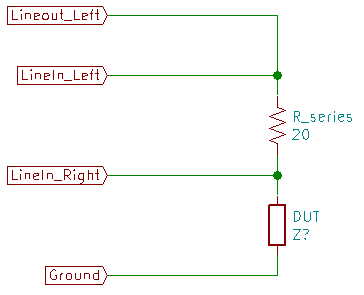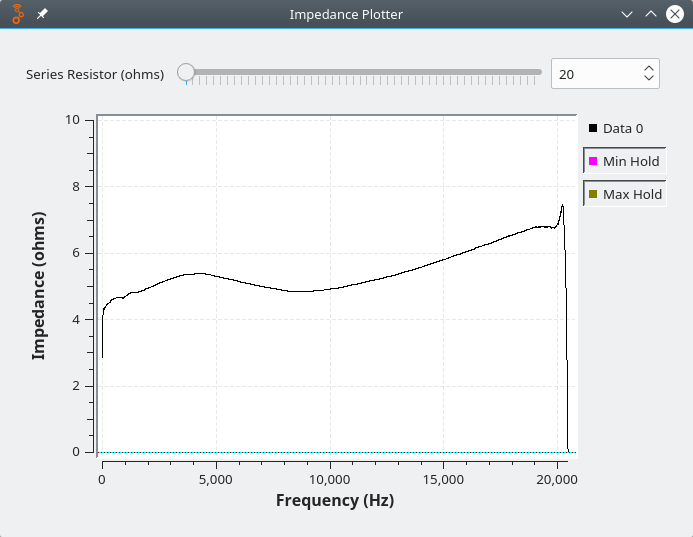i measured my cheap soundcards for their output z, and used this calculator for ease: Measuring input impedance and calculating output impedance calculation calculate audio amplifier op-amp how to measure impedance voltage gain total loudspeaker speaker microphone resistance resistor bridging matching test load loudspeaker source resi
this is the result, all measured at 300hz test frequency:
realtek headphone out:
Zout = 37 ohm (with Rload 10 ohm)
Zout = 30.6 ohm (with Rload 47 ohm)
uca202 headphone out:
Zout = 72 ohm (Rload 10 ohm)
Zout = 61.11 ohm (Rload 47 ohm)
uca202 line out:
Zout = 763 ohm (Rload 47 ohm)
umc22 headphone out:
Zout = 32.15 ohm (Rload 10 ohm)
Zout = 29.44 ohm (Rload 45 ohm)
umc22 line out:
Zout = 123.84 ohm (Rload 47ohm)
sb live! headphone out:
Zout = 3.88 ohm (Rload 10 ohm)
Zout = 1.91 ohm (Rload 47 ohm)
i have always thought i get the best impedance measurements results when used my very old sb live!, can the low output impedance be the reson?
this is the result, all measured at 300hz test frequency:
realtek headphone out:
Zout = 37 ohm (with Rload 10 ohm)
Zout = 30.6 ohm (with Rload 47 ohm)
uca202 headphone out:
Zout = 72 ohm (Rload 10 ohm)
Zout = 61.11 ohm (Rload 47 ohm)
uca202 line out:
Zout = 763 ohm (Rload 47 ohm)
umc22 headphone out:
Zout = 32.15 ohm (Rload 10 ohm)
Zout = 29.44 ohm (Rload 45 ohm)
umc22 line out:
Zout = 123.84 ohm (Rload 47ohm)
sb live! headphone out:
Zout = 3.88 ohm (Rload 10 ohm)
Zout = 1.91 ohm (Rload 47 ohm)
i have always thought i get the best impedance measurements results when used my very old sb live!, can the low output impedance be the reson?
Last edited:
Hi celef
If you use a sweep frequency as a current source (Audio Precision or equivalent test system) you can get a nice graph of Z vs Freq. Look @ LinkedIn, Classic AP Audio Systems Group LA:, Post "I had a customer that wanted to measure the output Z of a large DC Power supply. I sent the test for measuring Speaker Z as he has a System One."
Duke
If you use a sweep frequency as a current source (Audio Precision or equivalent test system) you can get a nice graph of Z vs Freq. Look @ LinkedIn, Classic AP Audio Systems Group LA:, Post "I had a customer that wanted to measure the output Z of a large DC Power supply. I sent the test for measuring Speaker Z as he has a System One."
Duke
What do you mean by best? It depends on your method, but generally lower output impedance is better. Headphone outputs are not really suitable for this purpose in my opinion because of the output impedance, but also they will have high distortion with speaker loads.
I use a proper power amp from the souncard line output when doing T/S measurements.
I use a proper power amp from the souncard line output when doing T/S measurements.
Last edited:
> Zout = 37 ohm (with Rload 10 ohm)
> Zout = 30.6 ohm (with Rload 47 ohm)
I'm puzzled why Zout goes down as Rload goes up.
In my lab, loudspeaker Z measurements were done with a Power Amp and a series resistor. When I was doing this "all" the time, I modified a Heath oscillator with an LM383 power chip and a 10.0 ohm resistor, on an added terminal.
> Zout = 30.6 ohm (with Rload 47 ohm)
I'm puzzled why Zout goes down as Rload goes up.
In my lab, loudspeaker Z measurements were done with a Power Amp and a series resistor. When I was doing this "all" the time, I modified a Heath oscillator with an LM383 power chip and a 10.0 ohm resistor, on an added terminal.
While playing with (learning about) GNU Radio, I put together a speaker impedance measuring program.
Given the way it works, the output impedance of the soundcard shouldn't matter.
I described it and its use in a series of blog posts.
The software is available on GitHub.
You need GNU Radio, Python 2, and a couple of other things all described in this blog post.
You hook it up this way:

Where "DUT" is the speaker.
The output looks like this:

It has a measurement cursor for getting precise numbers for any displayed frequency.
All of the software components are free to use, and my part is under the GPL - also free to use and modify.
All of the necessary software is cross-platform. It should run on Windows, Linux, and Mac. Since I only have Linux here, it hasn't been tested on Windows or Mac.
Given the way it works, the output impedance of the soundcard shouldn't matter.
I described it and its use in a series of blog posts.
The software is available on GitHub.
You need GNU Radio, Python 2, and a couple of other things all described in this blog post.
You hook it up this way:

Where "DUT" is the speaker.
The output looks like this:

It has a measurement cursor for getting precise numbers for any displayed frequency.
All of the software components are free to use, and my part is under the GPL - also free to use and modify.
All of the necessary software is cross-platform. It should run on Windows, Linux, and Mac. Since I only have Linux here, it hasn't been tested on Windows or Mac.
The generator output impedance appears as an error contributor, that is well explained in the ARTA LIMP manual.